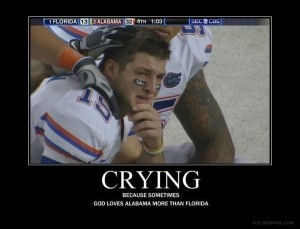
[Author’s Note: After writing and posting this, the Broncos went on to face the New England Patriots in their final playoff game (the 18th of the Broncos’ season). The Broncos lost SPECTACULARLY, 10-45. This makes their record of wins/losses now to be 9/9, exactly 50% . . . the coin flip would have been just as good in determining the outcome of the Broncos’ season as the actual season. ]
Let me say that I have nothing against Tim Tebow. He seems like a fine young man. He’s certainly very religious; although, ironically, he behaves in a way strongly inconsistent with the teachings of the very person to whom he proclaims a public faith: Jesus. Recall that, according to the Bible, Jesus taught:
And when thou pray, thou shall not be as the hypocrites are: for they love to pray standing in the synagogues and in the corners of the streets, that they may be seen of men. Verily I say unto you, They have their reward. But thou, when thou pray, enter into thy closet, and when thou hast shut thy door, pray to thy Father which is in secret . . . [Matthew 6:6 & 7]
The public reaction to Tim Tebow, however, is the pseudoscience gift that keeps on giving. As I discussed in my last post about him [1], he was hailed in the sports press with mixed reviews (both as a terrible quarterback and as an exciting quarterback). He had captured media stardom with a combination of excessive public religiosity and “sudden comebacks” (more on that below). But overall his performance was statistically uninteresting. As I noted, the Broncos’ rate of winning 1, 2, 3, or 4 games in a row as “comebacks” followed a roughly exponentially decreasing trend (the rate of winning 2 in a row by comeback is half that of 1 in a row; the rate of 3 in a row is about half that of 2 in a row; etc.). Based on that trend, the Broncos were right on track for 4 comebacks in a row, whether or not Tebow was the QB.
Now that the Broncos have completed a lot more of the current season, we can really look at Tebow and see how he ranks up against the “greatest” quarterbacks in NFL history. Let’s see what we find.
First, we need some “great” quarterbacks. I want ones from the last 30 years, so that they are playing in the most modern context of American Football. Here is the opinion of Jason Whitlock at Fox Sports [2]:
- John Elway (Denver Broncos)
- Joe Montana (San Francisco 49’ers)
- Johnny Unitas (Baltimore Colts)
- Dan Marino (Miami Dolphins)
Based on my own knowledge of Football history, I wouldn’t disagree with these. Conveniently, Tebow and Elway play for the same team. I will ignore Unitas because of how long ago he played the game.
I am primarily interested in their QB stats in the first 2 years of play, to see whether Tebow is really an anomaly compared to the greats. What are the good stats? One men’s magazine article claims the most important QB statistics are:
The single most important statistic for judging quarterbacks is yards-per-attempt (YPA). This illustrates a player’s efficiency. Even though they are highly correlated, it is also important to look at completion percentage as well. This is more indicative of consistency and is not as related to the ability of receivers to run after the catch. Along with YPA and completion percentage, quarterbacks are successful if they do not turn the ball over. Again, everything is relative, so we must account for the total number of pass attempts. Interceptions per 500 pass attempts is a stat that is easy to compare. After those items, mobility is very valuable. [3]
Here are some stats [4].
Yards Per Attempt (YPA) in first two years
The first number is their first year of play, the second number is the second year of play. The errors are obtained by propagating the Poisson uncertainties on the Yards Gained by Passing and the Number of Attempted Passes.
- Elway: (6.4 +/- 0.4) and (6.8 +/- 0.4)
- Montana: (4.2 +/- 1.0) and (6.6 +/- 0.4)
- Marino: (7.5 +/- 0.5) and (9.0 +/- 0.4)
- Tebow: (8.0 +/- 0.9) and (6.4 +/- 0.4)
The numbers are very revealing. The error-weighted average of the “best QB” YPAs is (7.17 +/- 0.03), while Tebow has a YPA of (8.0 +/- 0.9) in year 1 and (6.4 +/- 0.4) in year 2. Unlike the great QBs, Tebow’s performance decreases in his second year (albeit with a large uncertainty on the YPA in his first year due to the few passes he got to throw in his first season). In Tebow’s second season, his is well below the average of the greats.
Interception Percentage (Interceptions per attempt to pass) in first two years
The first number is their first year of play, the second number is the second year of play. The errors are binomial.
- Elway: (5.4 +/- 3.6)% and (3.9 +/- 3.8)%
- Montana: (0.0 +/- 0.0)% and (3.3 +/- 3.0)%
- Marino: (2.0 +/- 2.4)% and (3.0 +/- 4.1)%
- Tebow: (3.7 +/- 1.7)% and (2.2 +/- 2.4)%
In general, great QBs have interception rates consistent with zero within the binomial errors. Tebow exhibits the most significant interception rate (in his first year). Compared to other great QBs, his rate is higher than 2/3 of the other three and in his second year is lower than all three. This is one place where Tebow superficially looks good, but when you take into account uncertainties it’s tough to really distinguish anything here.
Pass Completion Rate (Percentage) in first two years
The uncertainties are binomial. The first number is their first year of play, the second number is their second year of play.
- Elway: (47.5 +/- 6.5)% and (56.3 +/- 4.5)%
- Montana: (56.5 +/- 18.3)% and (64.5 +/- 4.5)%
- Marino: (58.5 +/- 4.9)% and (64.2 +/- 3.1)%
- Tebow: (50.0% +/- 11.0%) and (46.5 +/- 6.5)%
The great quarterbacks tended to complete passes at a rate better then 50/50; that is, better than flipping a coin and deciding whether the pass is completed based on complete chance. Elway is the exception, although he improved considerably in his second year. Two of the top 4 greatest quarterbacks achieved completion rates well above 50% by their second year (about 64% for Montana and Marino). In all cases, the great quarterbacks IMPROVED their pass completion rate by their second year.
Tebow bucks the “trend of the greats” in a couple of ways. His performance WORSENS in his second year (albeit consistent with a flat performance within uncertainties) and it’s never better than flipping a coin. In fact, by his second year you could have flipped a coin every time he made a pass and have completed more passes by calling “HEADS!” than by letting Tebow’s pass actually decide whether completion occurs.
Summary
Is Tim Tebow a remarkable QB? Not really, according to empirical data. In two of the three major statistical categories, Tebow is not at or above the greatest recent quarterbacks; in the third, his ranking is indeterminate. His pass completion rate is no better than a coin flip, and in fact was WORSE this year. His interception percentage may be a bit smaller than others, but the uncertainties are large on all numbers presented. His Yards per pass attempt are unremarkable compared to the great quarterbacks. In two of the three stats categories, his performance worsened in his second year whereas the great quarterbacks improved.
Looking at the Denver Broncos total record, they played 17 games. Of those, they won 9 and lost 8. Their rate of winning games was slightly better than the rate of getting heads or tails in a coin flip. Certainly, considering just 17 such coin flips their performance is completely consistent the rates of heads and tails over many successive groups of 17 trials. They had one “streak” of 4 comebacks mid-season, which was then followed by 4 successive losses (which nobody seemed to call a “loss streak” initiated by Jesus’ displeasure with Tim Tebow). In fact, everything about the Broncos’ performance in 2011 is consistent with a sequence of coin flips, including “apparent streaks” of both wins and losses. This is all consistent with random numbers.
So I don’t see what all the fuss is about. Tim Tebow’s throwing arm is about as interesting as flipping a coin. If the fuss is about his religiosity, then the numbers suggest prayer isn’t helping him. But then, controlled studies of prayer also tell us that this practice confers no measurable benefits [5]. So, pretty much, this guy is uninteresting in both a secular and a religious sense.
I suspect that Tebow’s popularity is due more to the problems that we, as humans, have with data. We remember the hits (the Denver Broncos won 4 games in a row, by comeback, with Tebow as QB) and forget the misses (the Denver Broncos lost 4 games in a row, with Tebow as QB). That is why it is always important to evaluate a situation not based on personal biases (e.g. liking Tebow because he prays in the end zone) but on empirical evidence. The evidence says he’s not a great QB. Maybe, with more practice, Tebow will improve. I hope so, since he seems like a nice guy. But a nice guy is not necessarily a great QB.
[1] http://steve.cooleysekula.net/blog/2011/12/17/the-tebow-distribution/
[2] http://www.askmen.com/top_10/sports_100/135_fitness_list.html
[3] http://msn.foxsports.com/nfl/story/the-10-greatest-qbs-of-all-time
[4] http://www.pro-football-reference.com
[5] http://articles.latimes.com/2006/mar/31/science/sci-prayer31
[6] http://www.buzzfeed.com/treyc/tim-tebow-crying-motivational-poster-uw5


